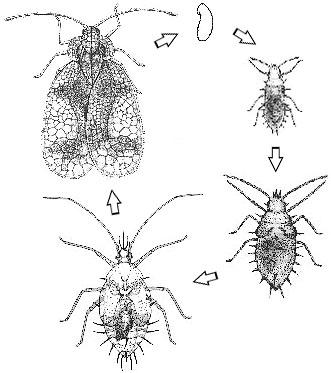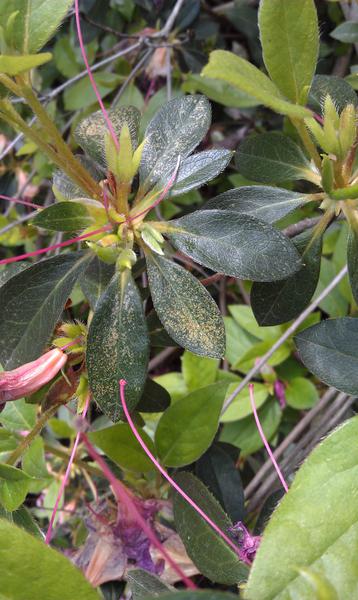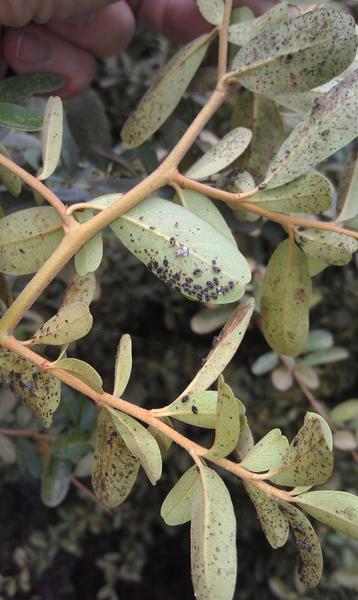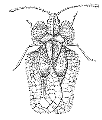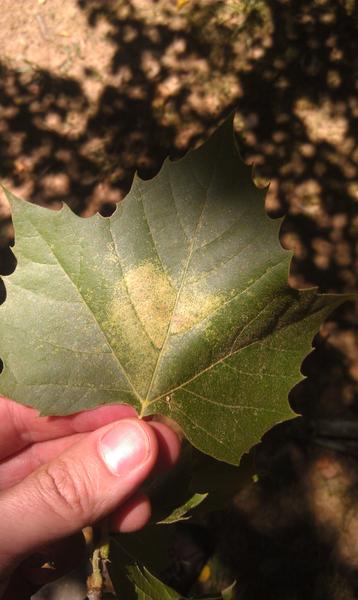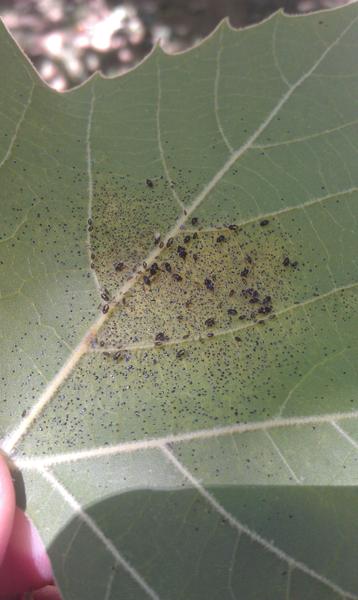General Information and Biology
There are more than thirty lace bug species in North Carolina. Most are not considered pests. The azalea lace bug may be the best known. Each species tends to feed only on it's preferred host and closely related plants. Lace bugs cause a blotched or spotted appearance of the upper leaf surface called stippling. This is caused when lace bugs insert their piercing-sucking mothparts into leaves to suck out chlorophyll and nutrients. Immature (nymph) and adult lace bugs are found mostly on the underside of leaves where they are protected from weather and predators. Spots of excrement resembling dark varnish are a distinguishing characteristic and appear on the underside of the leaves. Infested leaves turn gray or yellow and may drop from the plant.
Female lace bugs lay groups of eggs on the underside of leaves, most often along the midrib. These eggs are dark colored and are partially inserted into the leaf tissue or are pale and completely hidden inside the leaf. Dark, spiny nymphs hatch from the eggs.
Adult lace bugs have lace-like wings and an expanded, lacy hood back of the head. Most species of lace bugs in North Carolina produce two or more generations in a year. Following are brief descriptions of four of our most common lace bugs.
Adults are about 1⁄8 inch long and 1⁄16 inch wide. They have brown and black-marked wings. Their legs and antennae are light brown. Nymphs are almost colorless at birth but soon turn black and spiny. This insect usually spends the winter in the egg stage.
Azalea lace bug is found, to some degree, on most azaleas in the landscape. Damage may give the foliage a chlorotic bleached appearance. Many azaleas with problems are not planted correctly. Reduce the plant stress by providing the proper growing conditions and shade for azaleas. A diverse or more complex landscape may have fewer lace bug problems. Eggs hatch in spring so nsecticides applied in spring may reduce lace bug abundance and damage. Systemic and contact insecticides are available for the appropriate situations.
Adults of this species are small and dark. Hawthorn, cotoneaster, pyracantha and Japanese quince are the usual host plants. This insect may overwinter in the egg or adult stage.
Rhododendron Lace Bug
These lace bugs have black bodies about 3⁄8 inch long and grayish wings. They may attack rhododendron, mountain laurel and related plants. This lace bug overwinters in the egg stage on the plant.
The wings on the 1⁄8 inch long lace bug are almost transparent. Both nymphs and adults are black. Nymphs are spiny and very ugly. A complete life cycle takes only 30-40 days. In addition to sycamore, this pest has been known to attack ash, hickory and mulberry trees.
Control
Some varieties of azaleas, cottoneaster and other species damaged by lace bugs are more resistant than others. Lace bug management should start with resistant varieties planted and maintained to reduce stress and promote natural enemies. Insecticides should be applied when eggs hatch and nymphs appear in spring. Make sure the undersides of the leaves are covered or consider a systemic product. For the most current recommendations, and recommendations for specific situations, consult the North Carolina Agricultural Chemicals Manual. Some homeowner lawn and garden products containing some of these active ingredients may also be available.
The University of Georgia has identified varieties of azaleas less susceptible to lace bug damage.
Other Resources
- Insect and Related Pests of Shrubs. Baker, J. R. ed. 1980. NC Agricultural Extension Service publication AG-189. 199 pp.
- The Lace Bugs (Hemiptera: Tingidae) of North Carolina and Their Hosts. Horn, K. et al. 1979. NC Ag. Exp. Sta. Tech. Bulletin 257. 22 pp.
- Extension Plant Pathology Publications and Factsheets
- Horticultural Science Publications
For assistance with a specific problem, contact your local Cooperative Extension center.
Publication date: July 29, 2016
Reviewed/Revised: Sept. 25, 2019
Recommendations for the use of agricultural chemicals are included in this publication as a convenience to the reader. The use of brand names and any mention or listing of commercial products or services in this publication does not imply endorsement by NC State University or N.C. A&T State University nor discrimination against similar products or services not mentioned. Individuals who use agricultural chemicals are responsible for ensuring that the intended use complies with current regulations and conforms to the product label. Be sure to obtain current information about usage regulations and examine a current product label before applying any chemical. For assistance, contact your local N.C. Cooperative Extension county center.
N.C. Cooperative Extension prohibits discrimination and harassment regardless of age, color, disability, family and marital status, gender identity, national origin, political beliefs, race, religion, sex (including pregnancy), sexual orientation and veteran status.

